When I first started live blogging about the Great Tohoku Earthquake, I never expected I would still be doing it nearly a week later. I’ve had to archive important importation like this due to the sheer number of updates and hits I’ve been receiving. Below you will find the second part of the crisis unfolding.
**For the latest on the Great Tohoku Earthquake, click here.**
23.51 Latest figures from Asahi – 4851 dead. Over 520,000 taking refuge.
http://www.asahi.com/special/10005/TKY201103150488.html
23.40 With the recent quake that occurred in Shizuoka, a new hashtag emerged o Twitter: fujisan_nero – meaning ‘Go to sleep, Mt. Fuji!’. The epicentre was very close to the active volcano Mt. Fuji. It has not seen activity since the year 1707.
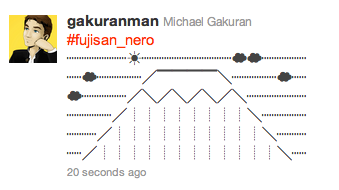
22.37 Quake was M6 at depth of 10km under Mt. Fuji, centered in east Shizuoka. We felt it over here in central Japan (a level 3 that shook for 10-20 seconds).
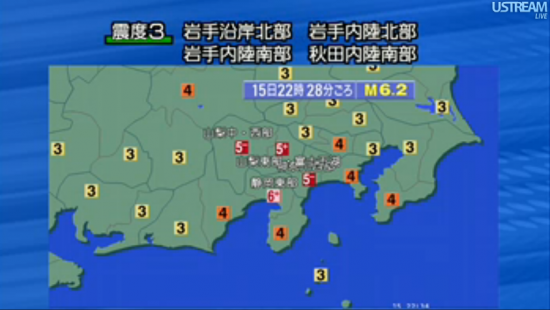
http://www.jma.go.jp/jp/quake/00000000053.html
21.50 Although radiation levels are still low and people outside the 20km evacuation area have little to worry about, here’s some safety information to prepare you.
Advisory 1
2011, March 15
[For more information about exposure to radiation]
8:30-17:15
090-5582-3521
090-4836-9386
[Due to the small number of phone lines, please understand that the lines may be very busy.]Advisory 2
Original here: http://www.nirs.go.jp/information/info.php?130General Decontamination Procedure (If water is unavailable)
Those concerned about possible exposure to radiation from the the Tokyo Electric Power Fukushima Dai-ichi nuclear accident should follow the steps below.
Even in cases of contamination, you can remove radioactive material using the following methods. After removed, there is no risk of the further spread of contamination.
Remove your clothes and shoes and place them in a plastic bag.
Wipe yourself down with cloth or a wet tissue (afterwards place the cloth or wipe in the plastic bag and throw the bag and its contents away).Advisory 3
Original here: http://www.nirs.go.jp/information/info.php?129General Decontamination Procedure (When water is available)
Those concerned about possible exposure to radiation from the the Tokyo Electric Power Fukushima Dai-ichi nuclear accident should follow the steps below.
Even in the case of contamination, you can remove a great deal of radioactive materials with the following methods.
Remove your shoes and clothes and place them in a plastic bag.
Wipe yourself down with cloth or a wet tissue (afterwards place the cloth or wipe in the plastic bag and throw the bag and contents away).
Follow the procedure below if shower is available
Wash your hair with shampoo.
Wash your face. (with soap or body wash)
Wash your body. Including the inside of your ears and under your fingernails (with soap or body wash)
Wash the clothes in the laundry or if you are still concerned, dispose of the clothes.National Institute of Radiological Sciences
22.00 Useful document translated into English that collects website links of various places in affected regions and other handy links.
http://www8.cao.go.jp/teiju-portal/jpn/etc/disaster/pdf/website-link.pdf
21.57 Latest figures: 3,300 dead. Together with the number of missing persons, the number tops 10,000.
http://www3.nhk.or.jp/news/html/20110315/k10014700671000.html
https://docs.google.com/document/pub?id=1XNokdW100MwfsWC89fzGtDqPtShbFd8Vh8BNssVpdVE&pli=1
21.39 More before-after pictures of the effects of the tsunami.
http://www.abc.net.au/news/events/japan-quake-2011/beforeafter2.htm
21.38 Latest TEPCO report. Radiation levels have again fallen. As of 18.00 the level was 0.4mSv with the wind in a south easterly direction.
http://www.tepco.co.jp/cc/press/betu11_j/images/110315g.pdf
21.32 Latest on reactor 4. Apparently two large 8m holes have been made in the outer wall housing the building of the reactor. An explosion was heard around 6.00 this morning and a fire recorded as having broken out at 9.00. It went out by itself by 11.00. TEPCO now think that the large increase in radiation noted today (400mSv) was from this explosion at reactor 4. Also, there is the possibility that the nuclear fuel rods are exposed to the outside. Unlike reactors 1-3, reactors 4-6 were in a state of rest and the nuclear fuel roads being stored in the spent fuel pool. With the explosion and two large holes now in the building of unit 4, it is possible that radiation is leaking out. TEPCO also gave some figures for the current temperatures in reactors 4-6. Reactors 5 and 6 are around 60 degrees, while reactor 4 is at 84. The usual temperature is 40 degrees. (via TBS, NHK)

http://www3.nhk.or.jp/news/html/20110315/k10014698981000.html
20.23 Here’s a fantastically lucid explanation for how an earthquake causes tsunamis fromt eh BBC. I had been wondering about this myself just yesterday, but it makes perfect sense.
http://www.bbc.co.uk/news/science-environment-12739417
19.44 Asahi Shimbun has added a chart showing risk levels of milli sieverts. The chart is not especially readable, but it confirms the information I posted earlier. If anything, it is more shocking than informative, detailing the nasty effects of extreme amounts of radiation.
http://www.bbc.co.uk/news/science-environment-12739417
19.44 Asahi Shimbun has added a chart showing risk levels of milli sieverts. The chart is not especially readable, but it confirms the information I posted earlier. If anything, it is more shocking than informative, detailing the nasty effects of extreme amounts of radiation.
50,000mSv – Death within 48 hours.
10,000mSv – Impaired consciousness
5,000mSv – Diarrhoea, bleeding, loss of hair
1,000mSv – Reduction of white blood cells
150mSv – Nausea
50mSv – Annual maximum amount of radiation allowed for those exposed through working in risk environments
6.9mSv – Chest CT scan
2.4mSv – Annual natural amount of radiation we all receive
1mSv – Limit of a person’s annual exposure to non-natural radiation (excluding medical examinations)
0.6mSv – Stomach X-ray
0.05mSv – Chest X-ray
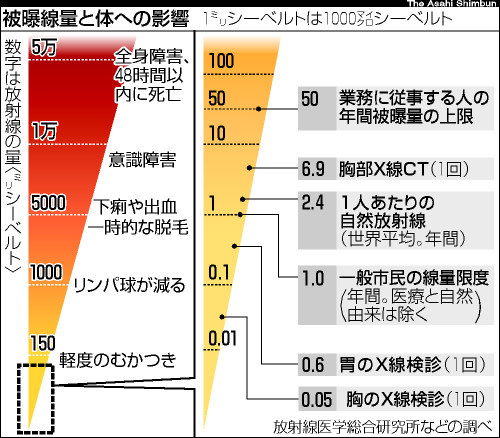
http://www.asahi.com/special/10005/images/TKY201103150240.jpg
19.33 Mutantfrog and Matt Alt have published insightful information about the current (non) nuclear situation in Tokyo. An absolute must read for anyone concerned about radiation. To be clear, at this point in time, the only real danger is inside and immediately around the power plant itself. Anyone outside the 20km radius will not have received a dosage of radiation that poses a threat to their health, assuming the statistics TEPCO and the government have given us are correct (and we can only trust them to be). In short, no need to panic.
http://www.mutantfrog.com/2011/03/15/radiation-safety-update/
http://altjapan.typepad.com/my_weblog/2011/03/should-i-stay-or-should-i-go.html
17.11 Regarding reactor 4, latest reports are saying that the water in the spent fuel storage pond at plant 4 has gone and that the nuclear rods are exposed. There is also the possibility that there was an explosion, but the cause has not been confirmed.
The report from earlier by the IAEA helps put what happened at reactor 4 in context. The fire there has since been extinguished.
Japan Earthquake Update (15 March 2011, 05:15 UTC)
by International Atomic Energy Agency (IAEA) on Tuesday, 15 March 2011 at 15:01Japanese authorities informed the IAEA that there has been an explosion at the Unit 2 reactor at the Fukushima Daiichi plant. The explosion occurred at around 06:20 on 15 March local Japan time.
Japanese authorities also today informed the IAEA at 04:50 CET that the spent fuel storage pond at the Unit 4 reactor of the Fukushima Daiichi nuclear power plant is on fire and radioactivity is being released directly into the atmosphere.
Dose rates of up to 400 millisievert per hour have been reported at the site. The Japanese authorities are saying that there is a possibility that the fire was caused by a hydrogen explosion.
The IAEA is seeking further information on these developments. The IAEA continues to liaise with the Japanese authorities and is monitoring the situation as it evolves.
http://www.facebook.com/notes/international-atomic-energy-agency-iaea/japan-earthquake-update-15-march-2011-0515-utc/201874423175685
http://www3.nhk.or.jp/news/html/20110315/k10014693561000.html
16.47 Press conference with Edano. Reactors 1 and 3 are currently stable with reactor 2 being cooled with water. Reactors 5 and 6 are under inspection to ensure problems do not occur. Current radiation levels at about 1mSv as measured by the entrance to the plant at 13.30. Previous figures showed 8mSv by the entrance. (via NHK t.v)
The 400mSv statistic revealed earlier is likely to have been taken directly around the damaged reactor in between the buildings. What is important to take away from all this, in my opinion, is the huge difference between the value recorded inside the plant and at the entrance. 8mSv is much lower than 400mSv, which shows just how much the radiation weakens as you move away from the source. Taking into account the 20km evacuation radius around the site, this means that people outside it are being exposed to very, very small amounts of radiation that will not pose a problem to their health. However, that is not to say that the situation is okay. Just as over the past few days, the possibility of further explosions and complications is a very real threat.
Official readings, wind directions (etc) taken by TEPCO at the plant
15.35 More stunning and moving pictures of the aftermath. Taking in all this from here in central Japan where life is going on as usual is strange. I can’t quite believe it’s the same country.
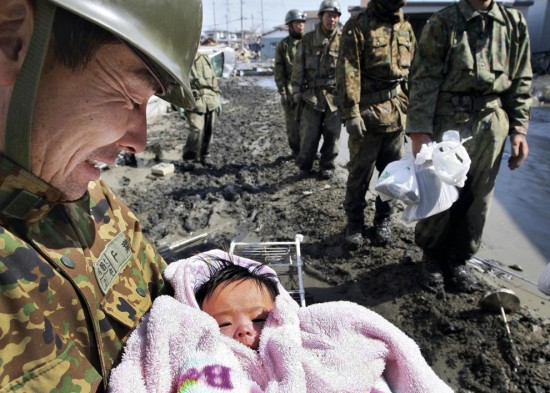
http://www.boston.com/bigpicture/2011/03/japan_-_vast_devastation.html
15.17 Japan police say death toll from quake has risen to 2,475, 3,118 people are missing, 1,889 have been injured. (via @DailyYomiuri)
15.08 The US Forces have helped the Japanese team fighting the fire at reactor 4, plant 1 in Fukushima. The fire has successfully been extinguished.
http://www.asahi.com/national/update/0315/TKY201103150203.html
14.37 Tiny amounts of radiation are reported to be reaching Tokyo. The amount is 20 times greater than then usual amount (0.035uSv), but still tiny at 0.809uSv (micro). It has since further fallen to 0.151uSv. So, to be clear, there is no danger to health!
http://www.yomiuri.co.jp/science/news/20110315-OYT1T00447.htm
14.04 Added English version of the image explaining radiation levels. Translation is crude and I didn’t have time to make it look nice, but hopefully it’ll dispel some of the myths.
13.45 To clarify. Previous amounts of radiation reported at the Fukushima plant were in Micro Sieverts (μSv). The latest radiation levels are Milli Sieverts (mSv) – in other words, the amounts are 1000 times greater. 1 mSv (milli sieverts) = 1000 uSv (micro sieverts)
(From Wikipedia:)
An older unit of the equivalent dose is the rem (Röntgen equivalent man). In some fields and countries, the rem and millirem (abbreviated mrem) continue to be used along with Sv and mSv, causing confusion. Here are the conversion equivalences:
1 Sv = 100 rem
1 mSv = 100 mrem = 0.1 rem
1 μSv = 0.1 mrem
1 rem = 0.01 Sv = 10 mSv
1 mrem = 0.00001 Sv = 0.01 mSv = 10 μSv
13.02 Evacuation area around Fukushima
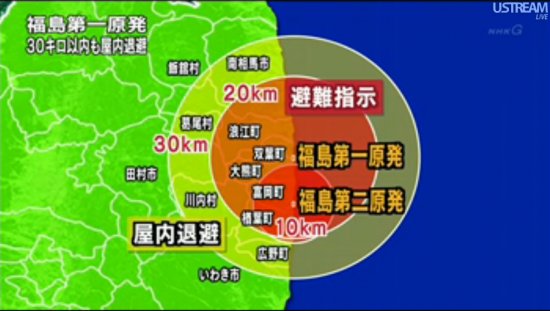
12.43 Here’s a chart showing the range of radiation levels in milli sieverts (mSv). Currently up to 400mSv per hour are being recorded in the immediate vicinity of Fukushima. Remember, although these figures may suggest that the level of radiation being recorded at Fukushima is not extremely high, the danger is constant exposure over a period of time. For this reason, people within the 20km evacuation zone are at high risk of serious harm.
7,000-10,000mSv – Person dies from radiation poisoning. (Full body exposure).
1,000mSv – Nausea and vomiting (Full body exposure).
500mSv – Decrease of lymphocytes in peripheral blood (white blood cells that defend your body) (Full body exposure).
200mSv – No clinical conditions confirmed below this number
10mSv – 1 year’s worth of natural radiation (Brazil)
6.9mSv – CT scan
2.4mSv – 1 year’s worth of natural radiation (world average)
1mSv – Limit of one’s year’s exposure to non-natural radiation (excluding medical examinations)
0.6mSv – Stomach X-ray
0.2mSv – A return air trip from Tokyo to New York
0.05mSv – Chest X-ray (or the level of radiation expected around a nuclear power plant – in practice it is much lower than this)
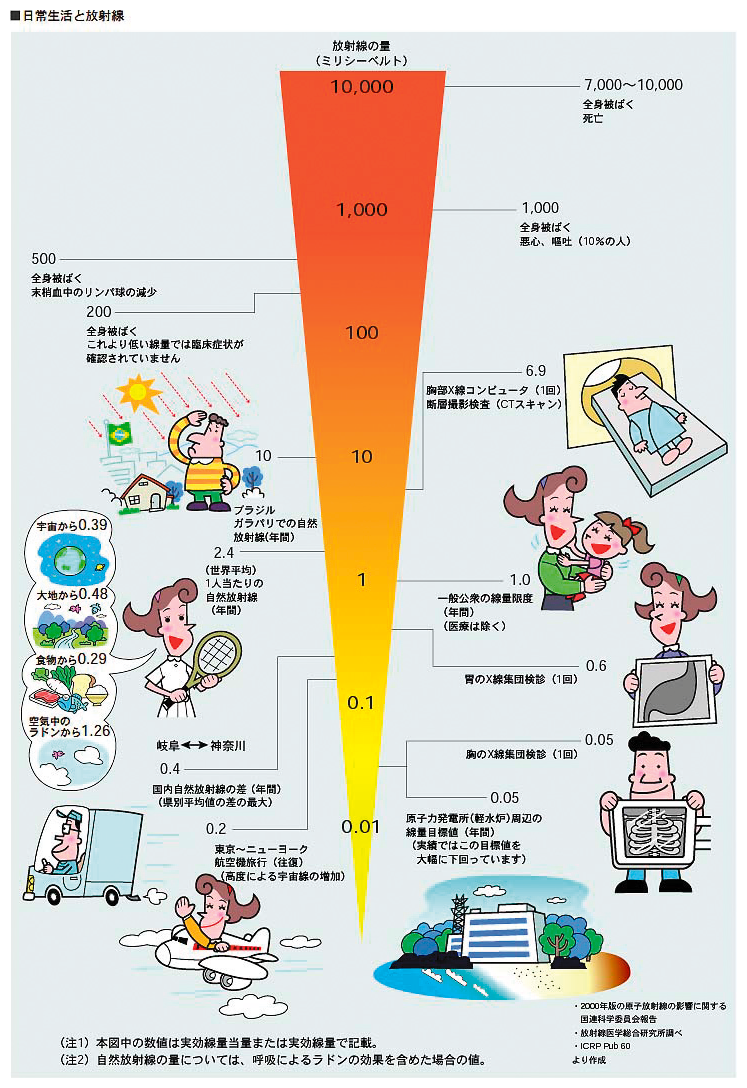
http://www.env.pref.kagoshima.jp/houshasen/kouhou/k18.html
12.13 Edano speculating that it is the fire at unit 4 that is responsible for the high amounts of radiation around Fukushima. Current recorded levels are as follows: 400mSv around unit 3, 100mSv around unit 4 and 30mSv 4 around units 1 and 2.
http://www3.nhk.or.jp/news/html/20110315/t10014681921000.html
11.56 Remember, Tokyo is over 200km away form the affected area in Fukushima. Evacuation radius currently at 20km, people within 20-30km should stay indoors.
11.53 US reportedly sending cooling agents. Current levels of radiation being recorded around unti 3, plant 1 are 400mSv. Serious levels that can affect health. Levels dramatically decrease if you move away form the source.
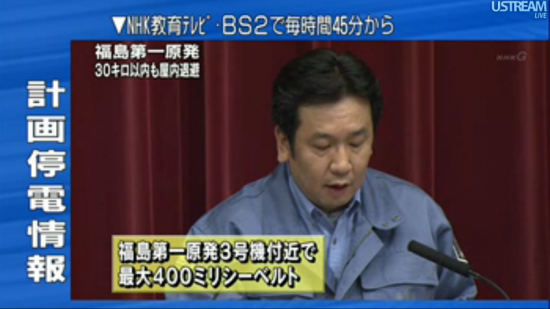
11.44 Water still being injected into reactors 1, 2 and 3 at plant 1. Government advising people within 30km to stay indoors, within 20km to evacuate. If going inside, take off clothes from outside first. Turn off air conditioning units and keep windows closed.
11.36 Catching up from what I missed. There was another hydrogen explosion, this time at unit 2, plant 1, about 6.00 this morning. This time the explosion was inside the compression chamber, closer to the reactor itself. I’m hearing via followers on Twitter that it was an internal explosion, not an external, superficial explosion like the ones that affected units 1 and 3.
Also, there is currently a fire at unit 4, hydrogen explosion suspected.
http://www3.nhk.or.jp/news/html/20110315/k10014681671000.html
http://www3.nhk.or.jp/news/html/20110315/k10014681321000.html
11.22 BREAKING NEWS. I just woke to hear hear a live press conference from the government. Level of radiation being recorded at Fukushima are being recorded at 100-400mSv – that’s milli Sieverts, NOT micro Sieverts we we hearing 6 hours ago. That’s over 1000 times higher. These ARE at serious levels that can damage health. People being advised to stay indoors, close windows, do not bring in objects from outside. Remember that this does not apply to the whole of Japan – the evacuation radius is 20km around Fukushima, and extending to 20-30km people should stay indoors.
**End Live Updates** I’m signing out for a while. Been up all night faffing around trying to clean up the mess than Dreamhost left when its servers went offline for hours and lost me a huge chunk of data.
05.41 Edano speaking. At Fukushima nuclear plant, units 1 and 3 are performing correctly, but unit 2 still has problems. The government will be setting up a special office inside TEPCO to more accurately and speedily get information out to the public. They will also attempt to solve the problem affecting the valve in the reactor. (via TBS)
05.00 Stunning video showing footage of the tsunami taken by local residents.
http://www.youtube.com/watch?v=GpuLlIrUYsI
04.48 Unit 2 in plant 1 is still in trouble. The team was able to restore the pump function and top up the reactor with cooling water around 01.00, but the level of water did not rise. As od 03.00, it is thought that the nuclear rods remain exposed.
http://www3.nhk.or.jp/news/html/20110315/t10014677231000.html
01.45 High amounts of radiation is reported being detected around the entrance area to plant 1. 3,130 micro Sv was seen at 21.37 and is 6 times the normal amount of radiation. The amount has since fallen back down into the low hundreds.
http://www3.nhk.or.jp/news/html/20110315/k10014676581000.html
01.28 Latest news at reactor 2, plant 1 in Fukushima. Apparently the vent to release vapour has struck shut, which means the pressure inside the reactor is increasing and that water cannot be pumped inside. This in turn means that the nuclear rods cannot be cooled and further heat up, causing steam and increasing pressure. If exposed for too long, the rods risk being damaged and causing a nuclear meltdown.
http://www3.nhk.or.jp/news/html/20110315/k10014676411000.html
March 15th, 2011
23.28 According to reports, the latest figures show 4,899 people dead or missing. Over 2000 bodies were found in Miyagi that have yet to be properly accounted for, so this number is expected to rise. Across the various prefectures affected, the current death toll is 1,897 people. Furthermore, there are updated statistics about the possibility of another serious aftershock. Originally it was predicted that there was a 70% chance of a level 7 earthquake within 3 days, but do to the aftershock subsiding recently, the estimate has been downgraded to a 40% chance of a level 5 earthquake within 3 days. If the earthquake occurs inland, then it is likely to be a level 6 if the earthquake.
22.50 Edano_nero is trending on Twitter. It means ‘Go to sleep, Edano!’ and is manifest of the gratitude felt by fellow twitterers for Edano’s tireless efforts to keep the public updated during this time. He is also showing great leadership with his direct and unwavering answering of the relentless media’s questions.
Amid the well-wishes and cheerleading messages being sent to those living in the disaster-ridden areas via Twitter, one of the few surefire ways to communicate in these times of disrupted networks, the Japanese have another message for someone else: imploring the government’s tireless spokesman Yukio Edano to get some rest.
The plea has grown so loud that the hashtag #edano_nero has become a global trending topic on the micro-blogging service on Monday. “Nero” means to sleep in Japanese.
…
During one of the dozens of press conferences he helmed Sunday night/Monday morning, Twitter users watching the live broadcast via online streaming provider Ustream rooted for the chief cabinet secretary, while howling when the local media peppered him with questions. One Twitter user cried, “Don’t waste his energy by asking ludicrous questions.”
…
Indeed, while it seems the previously beleaguered ruling Democratic Party of Japan has been cut some slack in the days since the crisis, that sentiment doesn’t seem to have extended to the prime minister. A new Twitter trend cropping up in conjunction with the one hailing the prime minister’s right-hand man is another called #kan_okiro. “Okiro” means to wake up in Japanese.
http://blogs.wsj.com/japanrealtime/2011/03/14/tireless-edano-earns-twitter-respect/
22.48 Another point that Edano made while speaking on television was that the Fukushima situation is not like Chernobyl. The problems at Fukushima have been controlled from the start and even in the worst case scenario is would not be a huge meltdown like Chernobyl was. (See further below where I posted a graph of this incident – a level 4 – vs. the Chernobyl incident – a level 7). (via NHK t.v)
22.23 Another large gap. Spent some time catching up and listening to live press conferences. There’s a lot of chatter about the current situation at Fukushima, but not a lot that’s new or useful. I’ve summarised it below.
Regarding unit 2 of plant 1, the cooling system has been fixed and sea water is being pumped into the reactor. Currently water levels are at about 2m high – half the height of the fuel rods inside the reactor – and much more stable than before.
http://www3.nhk.or.jp/news/html/20110314/k10014674681000.html
However, TEPCO has said that they cannot deny the possibility that the nuclear fuel rods have melted. The fueld rods were fully exposed for about 2 1.2 hours and radiation has been detected outside the reactor, adding further weight to the possibility that the nuclear fuel rods may have been damaged. The rods become exposed after the water levels dropped. It is supposed that this was due to the explosion at unit 3 earlier in the day, causing a glitch in the cooling system of unit 2.
http://www3.nhk.or.jp/news/html/20110314/t10014673231000.html
http://english.kyodonews.jp/news/2011/03/77870.html
20.42 Apologies, I popped out to get supplies in case these quakes started moving any further west. Updates I missed:
According to NHK, current casualty toll is 1,800+ dead, 15,000+ unaccounted for. (via Matt_alt)
The water levels cooling reactor 2 at Fukushima plant 1 fell quickly, exposing the nuclear rods inside the container. Exposure of rods for too long risks overheating and damaging them, which could lead to a meltdown. Fearing a hydrogen explosion like the one that occurred in units 1 and 3, the team has been quickly trying to fill the reactor with seawater.
http://www3.nhk.or.jp/news/html/20110314/k10014670071000.html
16.50 Edano has just polished off another set of piercing questions about the nuclear plants and blackouts. He is handling well under pressure and telling reporters straight when their questions are too technical and over his head. He also expressed his thanks to the people in Japan for cutting back on energy use which has led to not needing to implement all the intended blackouts so far. (via TBS)
16.34 State of emergency has been declared at reactor 2, plant 1 in Fukushima. Edano has instructed the team to prepare to pour sea water into the reactor to cool it.
http://www3.nhk.or.jp/news/html/20110314/k10014664971000.html
http://www3.nhk.or.jp/news/html/20110314/k10014664781000.html
16.09 With the latest figures, the number of people taking refuge in the 6 northern prefectures of Tohoku has risen to 433,423 spread over 2,067 locations.
http://www3.nhk.or.jp/news/html/20110314/k10014663351000.html
16.00 The cooling system at unit 2 in plant 1 at Fukushima has reportedly failed due to lack of water. Measures are being considered in dealing with it, including releasing more radioactive vapour.
http://www3.nhk.or.jp/news/html/20110314/k10014663951000.html
15.58 Quake warning in Nagano. Emergency system here in my city hall in central Japan began counting down suddenly giving me quite a fright. No shaking though.
14.53 Some perspective on the earthquake and tsunami including thoughts on how strict Japanese engineering saved thousands of lives.
http://www.kalzumeus.com/2011/03/13/some-perspective-on-the-japan-earthquake/
14.20 Mutantfrog has translated the reactor statistics for the two Fukushima plants. Useful reference:
http://www.mutantfrog.com/2011/03/12/vital-stats-of-the-fukushima-nuclear-plants/
14.00 How Tokyo is coping 72 hours after the quake (via @matt_alt)
http://www.cnngo.com/explorations/life/how-tokyo-coping-72-hours-after-quake-138741
13.55 No of people injured in the explosion at Fukushima plant 1, unit 3 has risen to 11.
http://www3.nhk.or.jp/news/html/20110314/k10014660411000.html
13.45 Useful Q&A on nuclear power stations if you are concerned about the effects of the small amounts of radiation given off:
http://smc-japan.sakura.ne.jp/?p=830
13.35 Current situation at Fukushima plant 1:
Japanese Earthquake Update (14 March 01:30 CET)
by International Atomic Energy Agency (IAEA) on Monday, 14 March 2011 at 09:38Based on information provided by Japanese authorities, the IAEA can confirm the following information about the status of Units 1, 2 and 3 at Fukushima Daiichi nuclear power plant.
Unit 1 is being powered by mobile power generators on site, and work continues to restore power to the plant. There is currently no power via off-site power supply or backup diesel generators being provided to the plant. Seawater and boron are being injected into the reactor vessel to cool the reactor. Due to the explosion on 12 March, the containment building has been lost.
Unit 2 is being powered by mobile power generators on site, and work continues to restore power to the plant. There is currently neither off-site power supply nor backup diesel generators providing power to the plant. The reactor core is being cooled through reactor core isolation cooling, a procedure used to remove heat from the core. The current reactor water level is lower than normal but remains steady. The containment building is intact at Unit 2.
Unit 3 does not have off-site power supply nor backup diesel generators providing power to the plant. As the high pressure injection system and other attempts to cool the reactor core have failed, injection of water and boron into the reactor vessel has commenced. Water levels inside the reactor vessel increased steadily for a certain amount of time but readings indicating the water level inside the pressure vessel are no longer showing an increase. The reason behind this is unknown at this point in time. To relieve pressure, venting of the containment started on 13 March at 9:20AM local Japan time. Planning is underway to reduce the concentration of hydrogen inside the containment building. The containment building is intact at Unit 3.
The IAEA is seeking information about the status of spent fuel at the Daiichi plant.
From the International Atomic Energy Agency
13.33 Current situation at Fukushima plant 2:
Japanese Earthquake Update (14 March 05:15 CET)
by International Atomic Energy Agency (IAEA) on Monday, 14 March 2011 at 13:12Based on information provided by Japanese authorities, the IAEA can confirm the following information about the status of Units 1, 2, 3 and 4 at Fukushima Daini nuclear power plant.
All four units automatically shut down on March 11. All units have off-site power and water levels in all units are stable. Though preparations have been made to do so, there has been no venting to control pressure at any of the plant’s units.
At unit 1, plant operators were able to restore a residual heat remover system, which is now being used to cool the reactor. Work is in progress to achieve a cold shutdown of the reactor.
Workers at units 2 and 4 are working to restore residual heat removal systems.
Unit 3 is in a safe, cold shutdown.
Radiation dose rate measurements observed at four locations around the plant’s perimeter over a 16-hour period on 13 March were all normal.
From the International Atomic Energy Agency
13.18 Re-adding the point about conserving energy. Cutting back energy on the 60Hz western network will not help those living on the eastern 50Hz network due to issues converting the signal. That said, reducing energy consumption is good in all ways, so I encourage everyone to do their part in reducing the amount of power used. (See Mutantfrog article below for more detail).
http://www.mutantfrog.com/2011/03/13/a-note-on-energy-conservation/
12.50 Press conference with Edano, Chief Cabinet Secretary. 6 people have been injured in the hydrogen explosion at unit 3, Fukushima nuclear plant 1. There was no damage to the reactor itself – only superficial damage to the outer housing surrounding it. The risk of radiation exposure very low – 50mSv/hour was initially observed but it soon dropped to 20mSv/hour. (via NHK t.v)
12.34 Nuclear situation in Fukushima is being rated as a level 4 risk on the International Nuclear Event Scale (INES) of 1-7. For reference, Chernobyl was a level 7 and the events of 1999 in Tokaimura were a level 4.
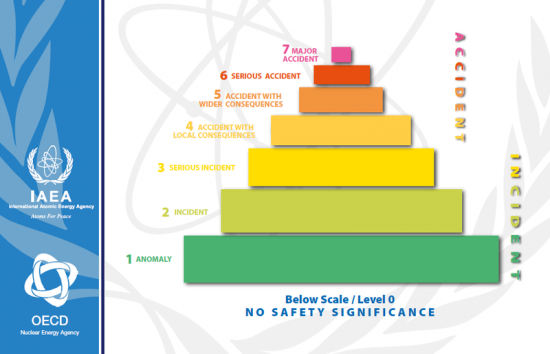
http://www-ns.iaea.org/tech-areas/emergency/ines.asp
12.26 6 people injured. 7 missing have been found (via TBS)
http://www3.nhk.or.jp/news/html/20110314/t10014659501000.html
12.19 On the powercuts: TEPCO says the initial 2 cuts planned for today didn’t occur. For the 3rd, they aren’t sure if these will take place yet. (via @timeouttokyo)
12.14 3 people are injured and 7 missing as a result of the latest explosion (via TBS)
http://www3.nhk.or.jp/news/html/20110314/t10014659231000.html
12.08 Interesting seismological data in this pdf file from the Japan Meteorological Agency (via @durf).
Original source: http://www.jma.go.jp/jma/press/1103/13b/kaisetsu201103131255.pdf
12.05 Several people injured in the latest explosion, including a worker at the plant.
12.01 Currently radiation levels around the area are not reported to have risen:
http://www3.nhk.or.jp/news/html/20110314/k10014658671000.html
11.56 Video of the explosion that has just occurred.
http://www.youtube.com/watch?v=pIZKlaEZMLY
11.52 Explosion at unit 3, plant 1 is reported to be another hydrogen explosion. Team looking into the situation to determine if there was any damage to the reactor. The 600 or so people in the area are being advised to stay indoors and take precautionary measures against radiation (via NHK t.v)
11.19 Black smoke is seen coming out of unit 3 at Fukushima nuclear plant 1. It looks like it may have been a hydrogen explosion similar to the one that occurred in unit 1 a couple of days ago. (via @shioyama, NHK)
11.09 Latest report as of 10.00 today says that 615 were unable to evacuate from around the Fukushima nuclear plant 1. They are mainly residents in care homes and hospitals.
http://www3.nhk.or.jp/news/html/20110314/k10014657071000.html
10.35 **Correction**. Apologies, I’ve been confusing the reactors and plants at Fukushima in translations so far. Important details are unaffected, but all previous updates should reflect this new information:
Problems are mainly at Fukushima nuclear power plant 1, in units 1, 2 and 3. There is a second plant a little further south and also a plant a Onagawa, about 100km away. The map below should help clarify this.
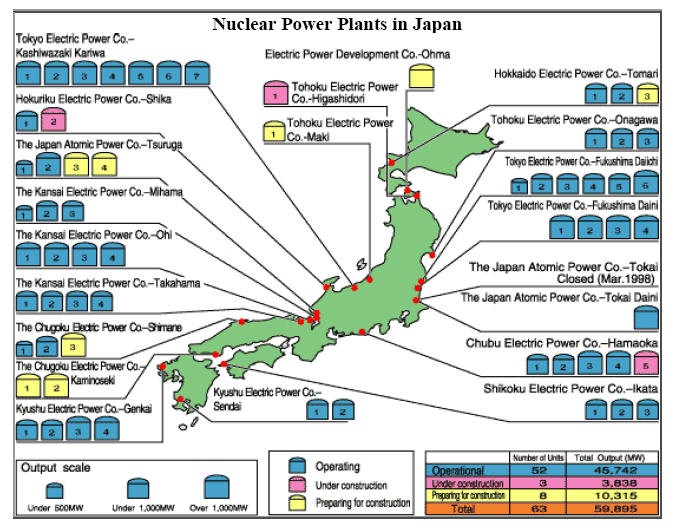
Up until now I had been using the word ‘plants’ to refer to the units/reactors that made up each plant – this was incorrect. There are two plants at Fukushima, each with several units. There are 6 units at plant 1 and 4 units at plant 2. Each unit has a nuclear reactor. I have gone back to correct this confusion throughout the article.
09.26 Latest on Fukushima: The cooling systems for units 1 and 2 at plant 2 are back online. The motor powering the pump at unit 1 was replaced at 3am and the pump for unit 2 at 7am this morning. Pressure levels are falling with the cooling systems back online. The team at Fukushima are working on restoring the cooling systems at unit 4.
http://www3.nhk.or.jp/news/html/20110314/k10014654571000.html
09.10 Latest on the blackouts. Conflicting reports say schedules have changed or certain time blocks have been cancelled. Check the latest schedules in Japanese here. Also, use the zip-code checker below to quickly and easily determine what time block you are in.
09.00 Live Updates Resume
**End live Updates** Okay all, I’m signing out for today. As I’m not living in an affected area (central Japan), I have work as usual early tomorrow morning. I will try to keep the live updates coming as best I can though. Peace.
01.50 Nuclear situation not a meltdown. Phone interview with Noriyuki Shikata, Deputy Cabinet Secretary for Public Relations (via @norishikata)
Even if there was an explosion at Fukushima unit 3, it would not damage the nuclear reactor or core – it would not be a ‘meltdown’. Shikata, in the phone interview, says:
“We don’t call this situation a meltdown – this is a regulated, controlled situation. The release off minute, radioactive materials is based on our efforts to take precautionary measures. It is an intentional incentive.”
01.27 List of blackout areas in one clear pdf file from METI
http://www.meti.go.jp/list.pdf
01.15 Latest updates on the controlled blackouts (all are subject to revisions by TEPCO) (via TBS)

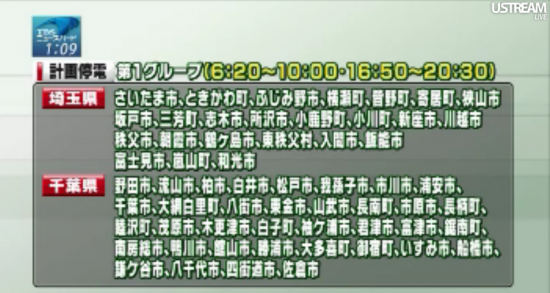
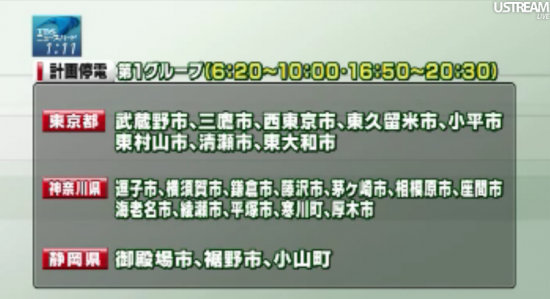
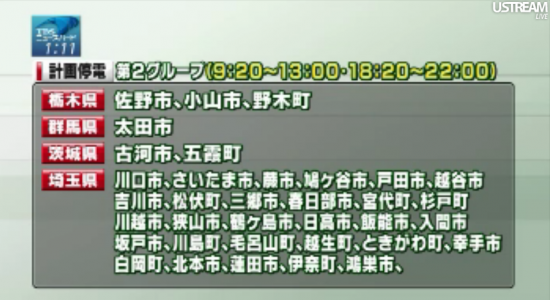
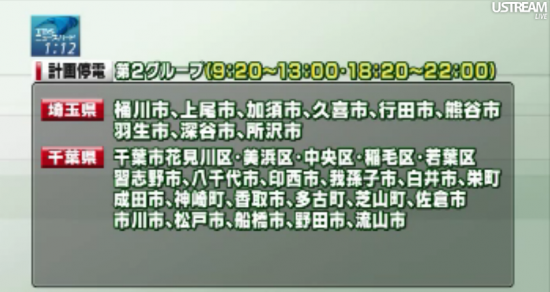
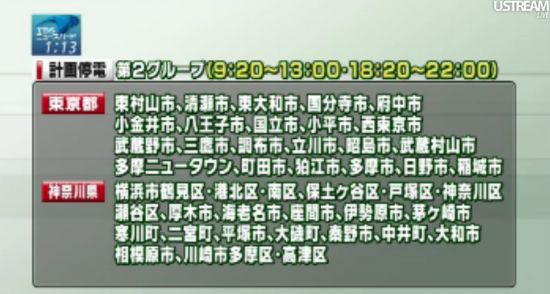
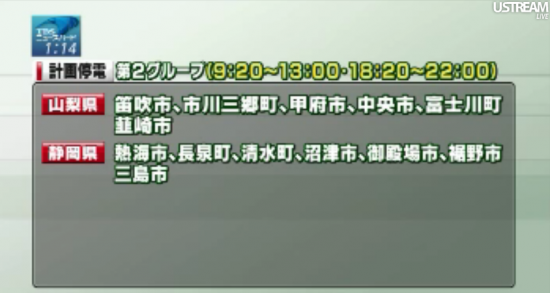
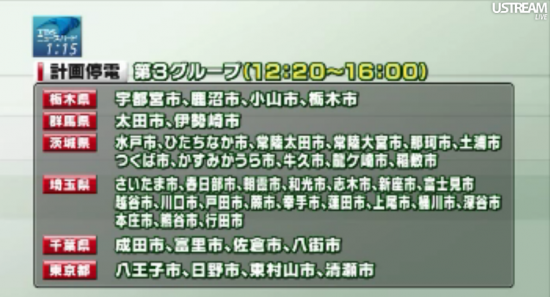
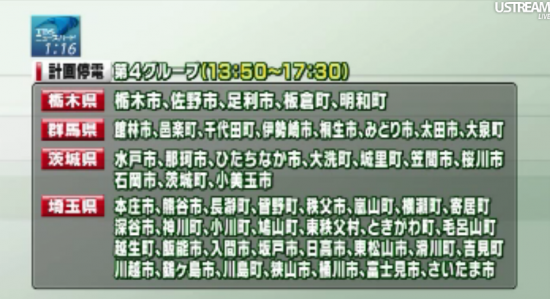
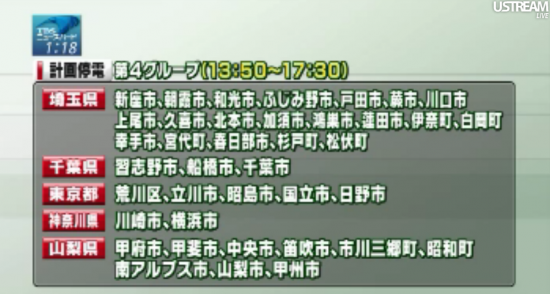
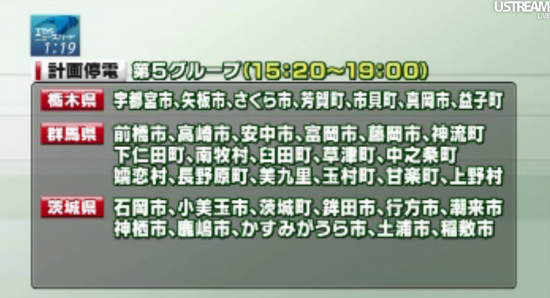
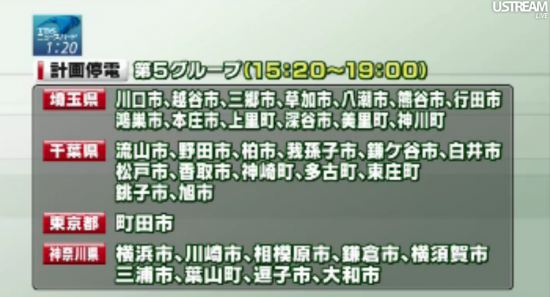
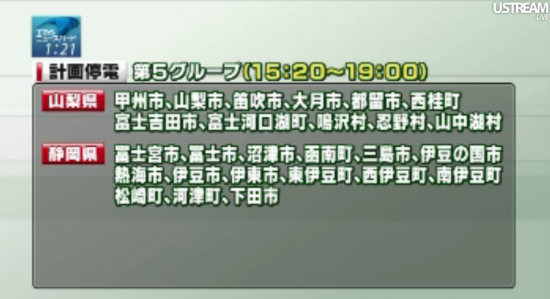
01.00 Current figures: Over 2000 dead, 1900 missing and nearly 2000 injured (via TBS).
00.15 METI’s Nuclear and Industrial Safety Agency conducted a press conference. The team working at unit 3 of the Fukushima nuclear power station succeeded in opening the valve to release pressure inside the reactor container. Currently the pressure is not high and water is still being pumped into the reactor itself to cool it. Around 100 people who where evacuated from the area were tested for radiation and decontaminated. Currently the levels of radiation in the area are not enough to pose a threat to health.
http://www3.nhk.or.jp/news/html/20110314/k10014652011000.html
March 14th, 2011









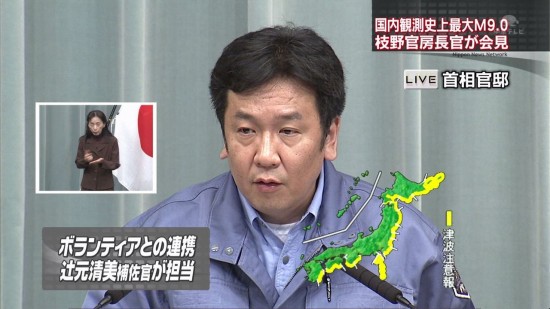
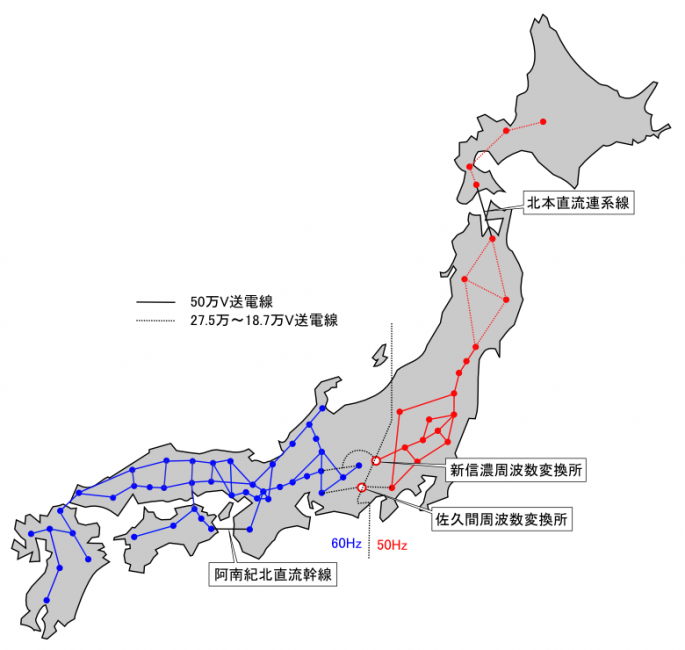
I like the way the are explaining the Fukushima melt down to kids
http://www.japansugoi.com/wordpress/cartoon-explaining-the-fukushima-nuclear-reactor-problem-to-kids/
Was watching CNN a few minutes ago and they seemed to be saying the U.S. was telling its citizens to evacuate considerably farther than the Japanese authorities. Even went into some scary stuff about shelters being too close to the nuclear reactor and that the U.S. doesn’t agree with what the Japanese authorities are doing. Is this just all fear propaganda?
CNN gets paid by ad revenue. Shock and fear brings more viewers than calm, level-headed reporters. If you want real news, pay attention to NHK who is not ad revenue based, so they don’t care about drumming up views.